Last updated: November 4, 2021
The quest for an affordable yet quality electric guitar often leads players down a rabbit hole of online reviews and forum discussions. If you’re on that journey and considering an S G Guitar, specifically the Firefly FFLG, you’ve landed in the right place. This in-depth Firefly FFLG guitar review for 2023 aims to answer the burning question: Is the Firefly FFLG a good guitar and, more importantly, is it worth your money?
To get a broader perspective, you might also want to read our related article on Firefly Guitars, where we delve deeper into the brand and its reputation for value-driven instruments.
Unlike many reviews you might encounter, this one is based on firsthand experience. I purchased the Firefly FFLG SG-style guitar in the striking red-black finish with my own funds. This review is completely independent; I have not been sponsored, nor do I receive any commission if you decide to buy a Firefly guitar through any links on this page.
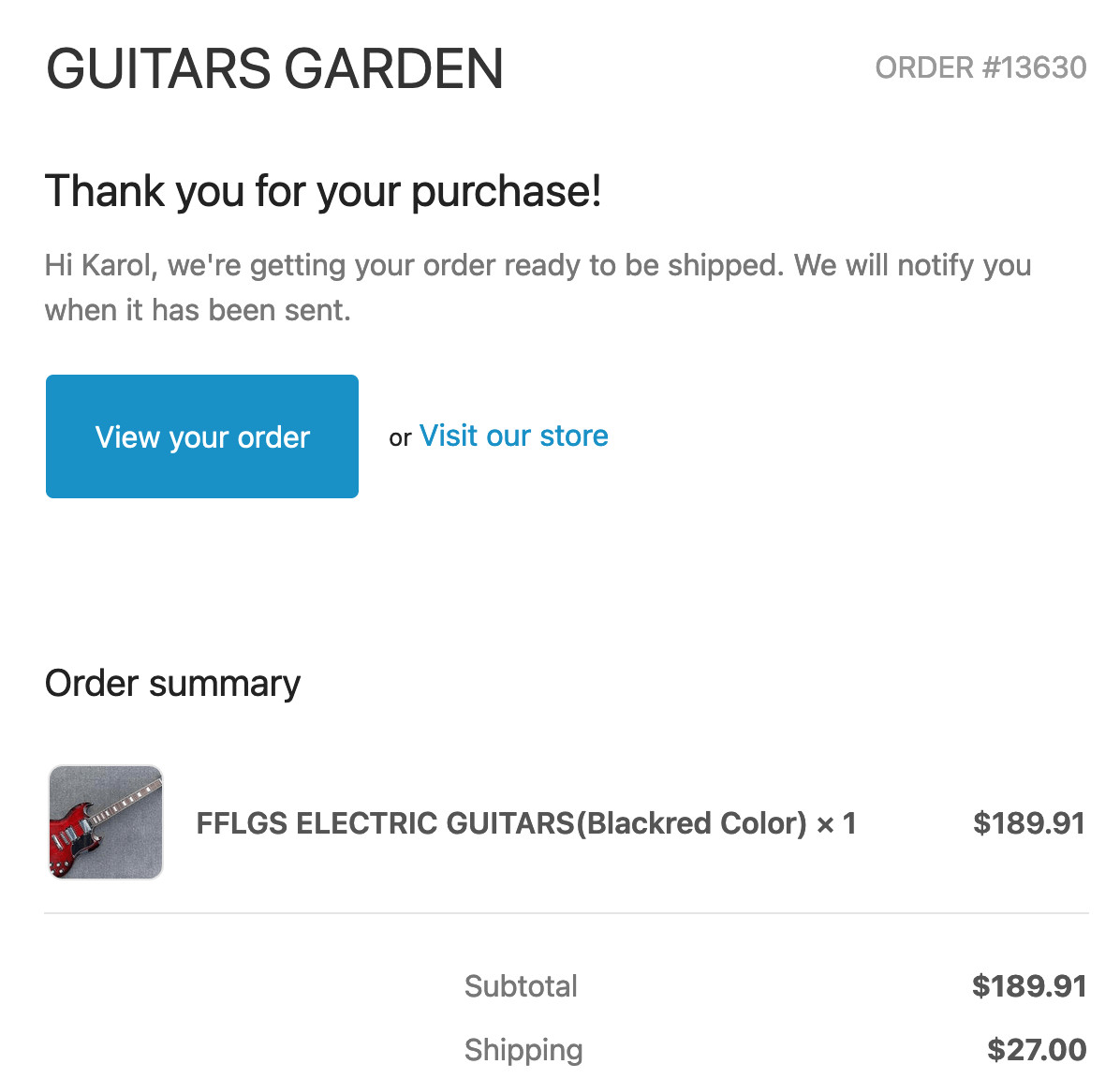 Price at the time of purchase shown. Current prices may vary.
Price at the time of purchase shown. Current prices may vary.
Spoiler alert: I’ve spent considerable time with this guitar – over 40 hours of playing to be precise. Like its sibling, the Firefly FFLPS, it required a setup to reach its full potential. I’ll detail the setup process shortly. For now, note that the sound demos in the video and on SoundCloud are from after the setup, so your initial experience right out of the box might differ.
Meet the Reviewer
Hi, I’m Karol – pronounce it like “Karl.” Guitar has been a passion for over 20 years, although I still consider myself an enthusiastic amateur, always learning. While I have a history of playing in a band in my younger days, these days guitar playing is purely for the joy of it.
Why should you trust this review? Because objectivity is key for me. I’m not here to push a sale or promote any brand for personal gain. Art Of Shred was born out of a frustration with the often biased nature of guitar and music gear reviews online. My goal is to provide honest, unfiltered opinions. Remember, these are my personal views, based on my experience. I don’t claim to know everything, and these are just my opinions.
Firefly FFLG SG-Style Guitar: Quick Verdict
7.6 out of 10
$216.91 (Price at purchase)
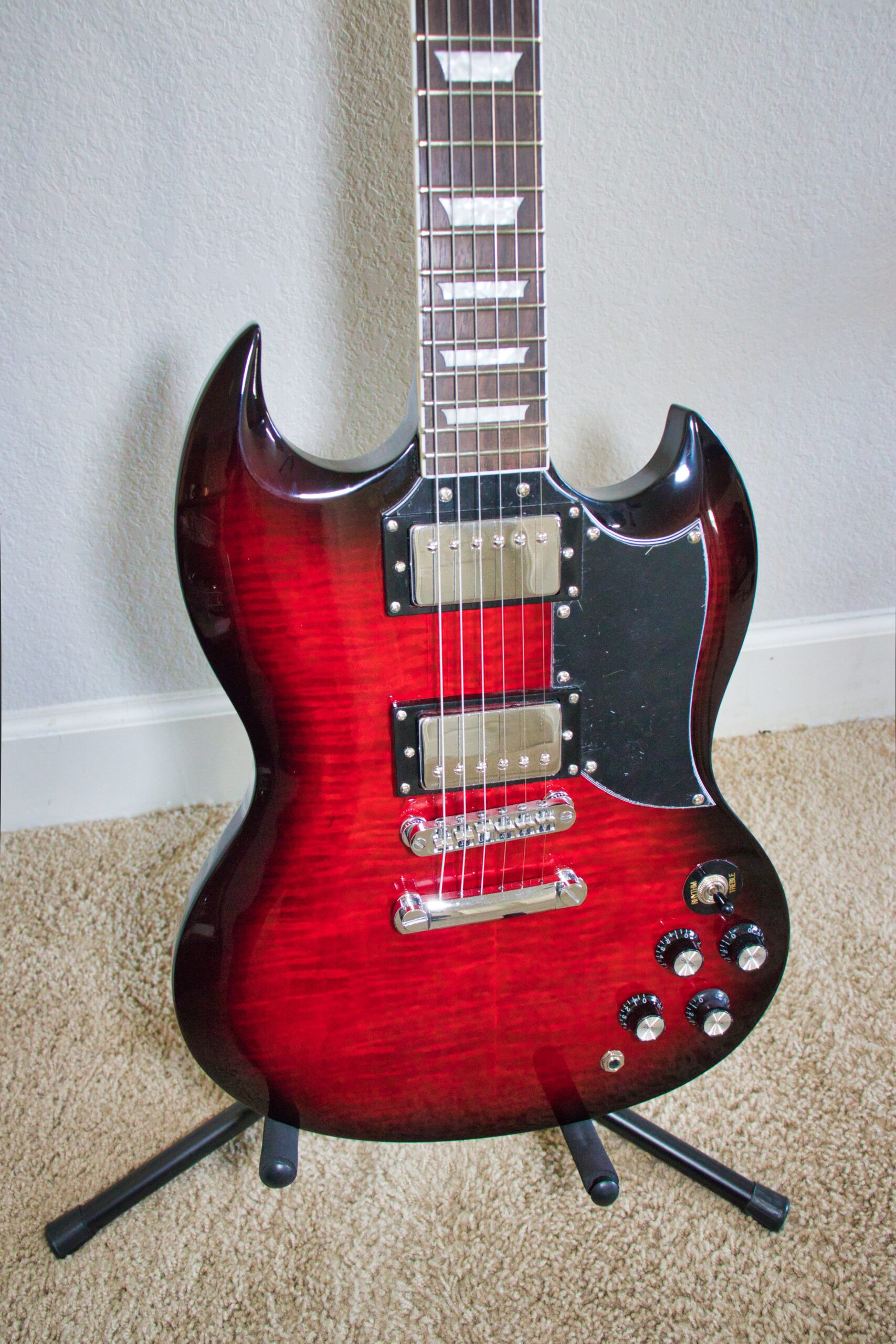 The Firefly FFLG SG-copy in Red & Black finish, a visually appealing and affordable option for players seeking the classic SG style.
The Firefly FFLG SG-copy in Red & Black finish, a visually appealing and affordable option for players seeking the classic SG style.
Country of Origin: China
| Feature | Rating |
|---|---|
| Looks | 8 out of 10 |
| Setup (Out of box) | 5 out of 10 |
| Feel | 8 out of 10 |
| Sound | 7 out of 10 |
| Value | 10 out of 10 |
Pros
- Visually appealing design
- Suitable for beginner to intermediate players
- Exceptional value for money
- Pleasing sound quality after setup
Cons
- Stock pickups are not high-end
- Requires truss rod adjustment upon arrival
- Frets necessitate thorough polishing
- May need component upgrades for experienced players
Where to Buy
Check Current Price
Explore Used Options
Video Companion Review
For those who prefer a visual overview, I’ve created a video version of this Firefly FFLG review. This written review complements the video, offering a more detailed examination. For the most comprehensive understanding, I recommend both watching and reading.
Unpacking the Basics of the FFLG SG Guitar
The Firefly FFLG is undeniably an homage to the iconic Gibson SG, a guitar shape revered in rock and roll history. It features the classic double-cutaway mahogany body, known for its lightweight feel and resonant tone. This s g guitar design is equipped with two humbucking pickups, controlled by a 3-way selector switch, dual volume knobs, and dual tone knobs – a standard configuration for this style of instrument.
GuitarsGarden, the retailer, lists specifications including a mahogany body and neck, a rosewood fretboard, and a bone nut. While I can’t definitively verify each material, the fretboard appears to be ovangkol, a sustainable alternative to rosewood that shares similar tonal characteristics. Ovangkol is increasingly common in modern guitar manufacturing due to rosewood regulations.
The FFLG is available in a range of finishes, encompassing both traditional SG colors and more contemporary options. I opted for the red finish, leaning towards a classic aesthetic. While the heritage cherry finish of a genuine Gibson SG remains iconic, Firefly offers a compelling visual alternative at a fraction of the price.
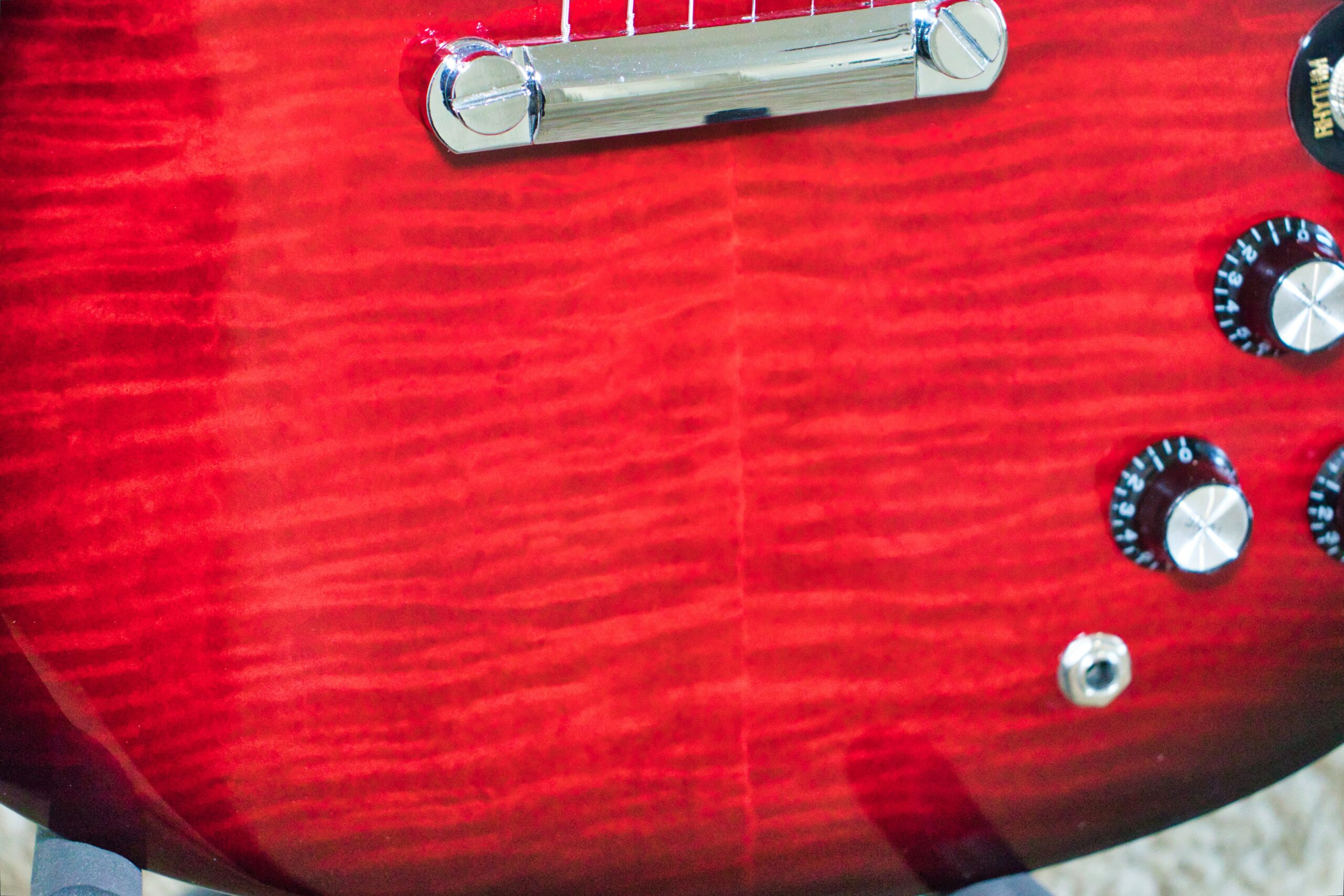 A closer inspection of the Firefly FFLG’s red and black finish, highlighting the quality of the finish for a budget-friendly guitar.
A closer inspection of the Firefly FFLG’s red and black finish, highlighting the quality of the finish for a budget-friendly guitar.
Initial Thoughts: Setting Expectations
Having previously reviewed and enjoyed the FFLPS, I approached the FFLG with optimistic expectations. I anticipated a similar level of quality and value, hoping there wouldn’t be a significant drop in standards.
Straight out of the box, the FFLG’s appearance was… adequate. The frets were coated in grime and oxidation, the neck had a slight bow, and the string action was set high. However, the finish itself was surprisingly well-applied, free of any noticeable flaws.
My initial impression was lukewarm. But, crucially, none of these issues seemed insurmountable. They were all typical of minor setup needs, not indicative of major manufacturing defects. Therefore, it’s fair to assess this guitar based on its “second impression” – after a proper setup. Before we delve into that…
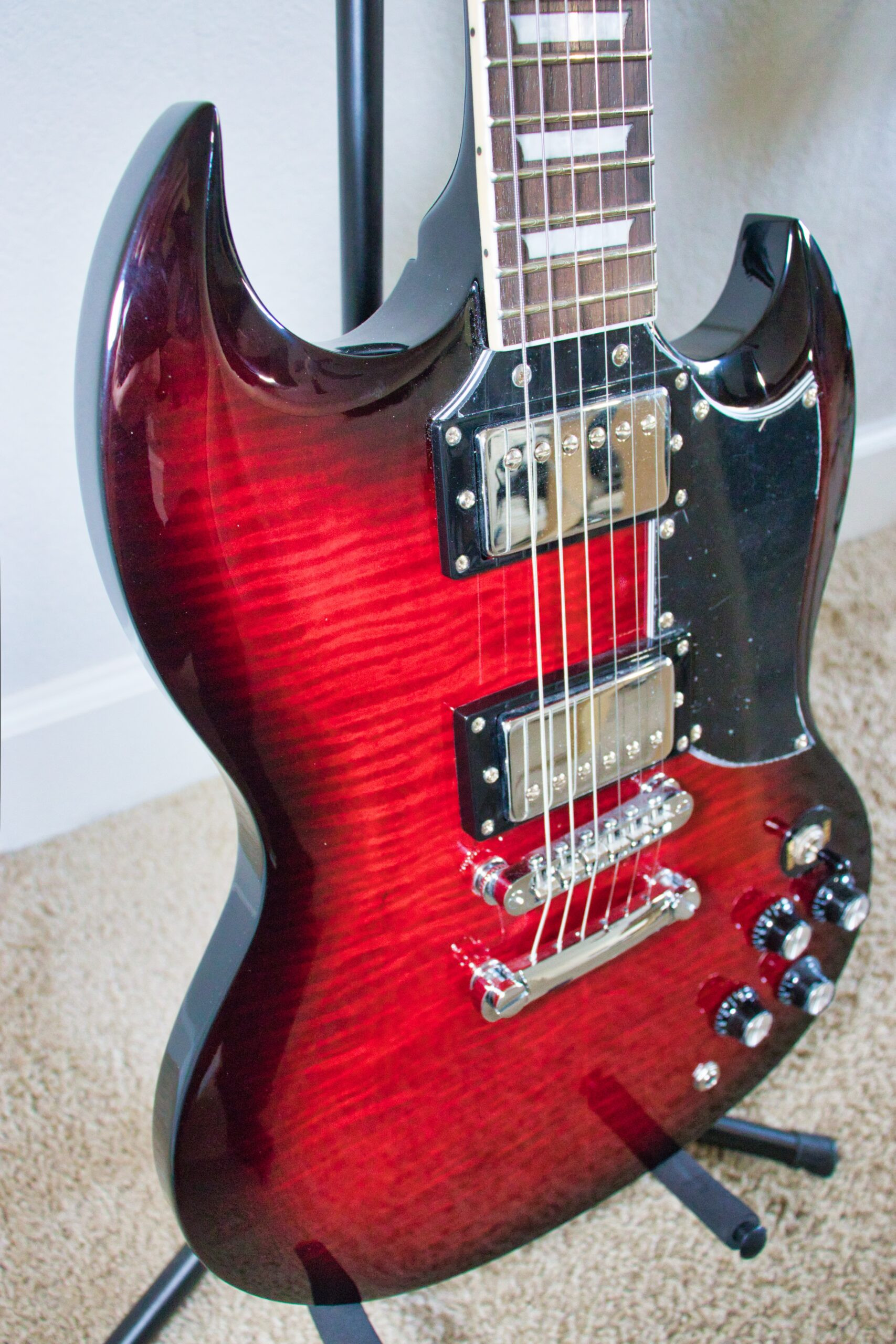 The Firefly FFLG prior to setup, illustrating the typical out-of-the-box condition that requires adjustments for optimal playability.
The Firefly FFLG prior to setup, illustrating the typical out-of-the-box condition that requires adjustments for optimal playability.
Digging into the Downsides (Cons)
- Pickups: The stock pickups are arguably the weakest link. They seem to be the same units used in the FFLPS. While they’ve grown on me somewhat, they lack the clarity and definition of higher-end pickups.
- Dirty Frets: The frets were exceptionally dirty, requiring significant polishing. This was an unexpected and time-consuming part of the setup.
- Dry Fretboard: The fretboard was noticeably dry and in need of conditioning. This is easily remedied with lemon oil.
- Basic Tuners: The tuners are functional but feel inexpensive. They are standard budget-guitar fare, not exceptionally bad, but not impressive.
- Neck Bow: The neck arrived with a slight bow, necessitating a truss rod adjustment. This is a common occurrence with guitars during shipping and temperature changes.
- High Action: The action was set above 2mm, which is too high for comfortable playing for most styles beyond slide guitar.
- Knob Aesthetics: Similar to the FFLPS, the volume and tone knobs appear somewhat cheap and detract slightly from the overall visual appeal.
Highlighting the Positives (Pros)
- Attractive Finish: The red-black finish is genuinely striking and well-executed, giving the guitar a premium look that belies its price.
- Inlay Quality: The fretboard inlays are neatly done and enhance the guitar’s visual appeal.
- Fretwork (Mostly): Importantly, there were no sharp fret ends (fret sprout) and no uneven frets causing buzzing.
- No Dead Frets: Every note across the fretboard rings out clearly without any dead spots.
- Solid Hardware (Bridge/Tailpiece): The bridge and tailpiece are functional, easily adjustable, and feel sturdy.
- Decent Stock Sound: While not top-tier, the pickups are not terrible. The guitar produces a usable and enjoyable sound, especially after setup. (Yes, the pickups are both a pro and con – they are adequate for the price point).
The Setup Process: Making it Playable
This Firefly FFLG, like many budget guitars, required a setup to unlock its playability. However, it was a simpler process than the FFLPS, primarily because there was no fret buzz on this guitar – no need for fret leveling or crowning!
The Filthy Fret Saga:
The most surprising and time-consuming aspect was the state of the frets. “Filthy” is almost an understatement. They were covered in a thick layer of oxidation and grime that required a thorough polishing. This alone took around 20 minutes. I’ve never encountered frets this dirty, even on neglected guitars. But after polishing, they gleamed beautifully.
Hydrating the Dry Fretboard:
A dry fretboard is a common issue, easily addressed. I used D’Addario lemon oil, but any quality fretboard conditioner will work. Applying lemon oil is a quick and simple five-minute task.
Truss Rod Adjustment for Neck Relief:
A slightly bowed neck is typical, especially with temperature and humidity changes during shipping. Wood is a natural material that responds to its environment! The truss rod needed about a quarter to a half turn to straighten the neck to my preference. Firefly thoughtfully includes the necessary Allen wrench. Don’t be intimidated by truss rod adjustments! It’s hard to cause serious damage if you proceed slowly and cautiously. Make small adjustments (quarter turns) at a time and observe the neck’s response.
Lowering the Action:
Like many guitarists, I prefer a lower action, around 1.5mm at the 12th fret. Out of the box, even after the truss rod adjustment, the action was still above 2mm. This is easily remedied by adjusting the bridge height using a flathead screwdriver. It took less than 5 minutes to lower the action to my preferred setting. (I demonstrate this briefly in the video review).
Beyond these steps, I lubricated the nut slots with graphite (pencil lead works perfectly) to ensure smooth tuning and installed a fresh set of strings. And that concluded the setup! Around 45 minutes of work transformed this guitar into a genuinely enjoyable instrument.
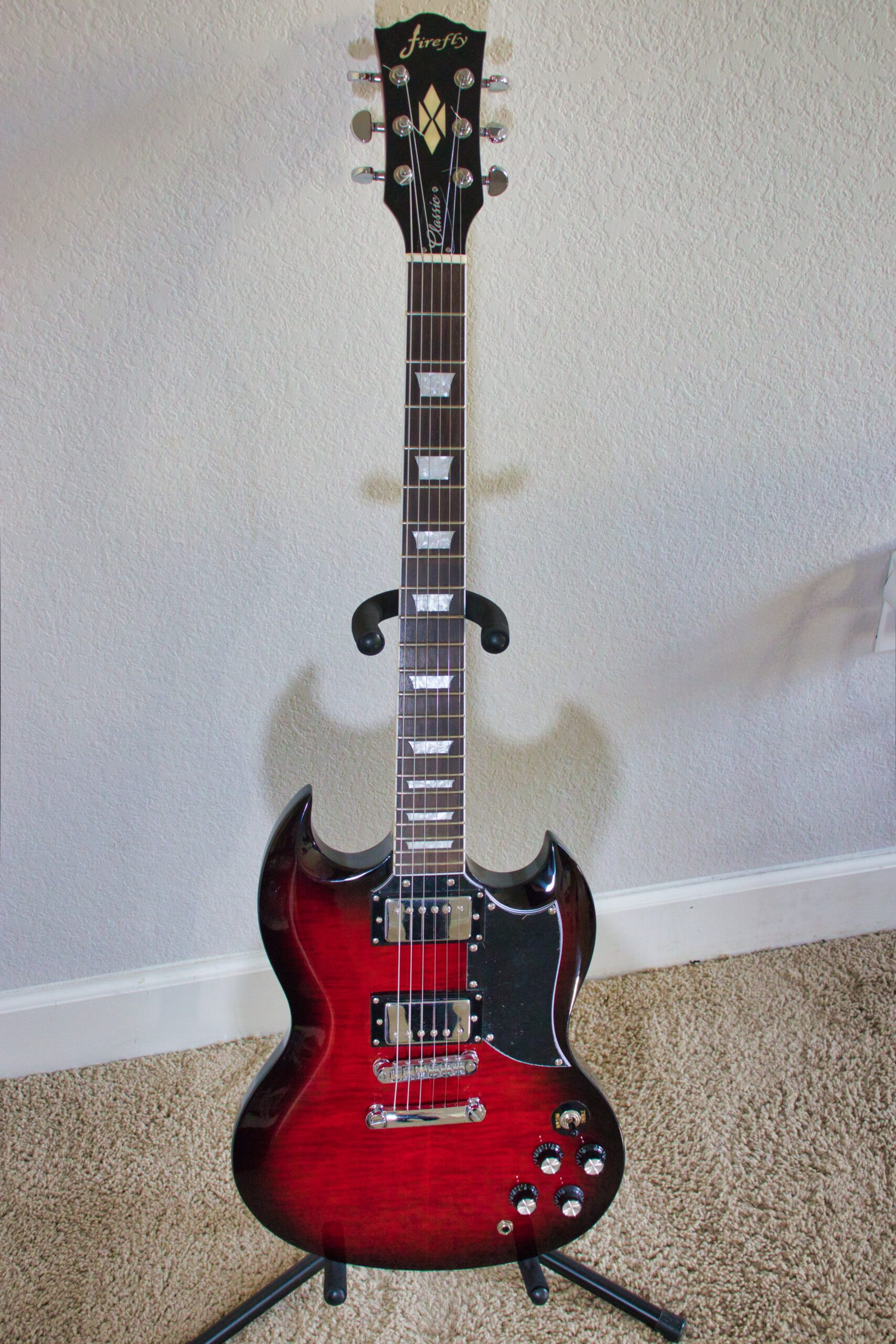 The Firefly FFLG after a comprehensive setup, demonstrating the significant improvement in playability and appearance achievable with basic adjustments.
The Firefly FFLG after a comprehensive setup, demonstrating the significant improvement in playability and appearance achievable with basic adjustments.
Sound Evaluation: Does it Rock?
Similar to the FFLPS, the primary limitation of the FFLG is the stock pickups. They are somewhat “muddy,” lacking the clarity and articulation found in higher-quality pickups. However, this is a common compromise in budget guitars. Manufacturers have to cut costs somewhere, and pickups are a frequent area. In fact, replacement pickups can easily cost more than the entire FFLG guitar itself. This is the reality of chasing tone on a budget.
But here’s the surprising takeaway: I genuinely like the sound! As with the FFLPS, the bridge pickup on the FFLG delivers a respectable crunch. It’s more than capable of handling rock and even venturing into metal territory. If I can play Black Sabbath riffs and not cringe at the tone, it passes a crucial test for me. The FFLG clears this hurdle with ease. The clean tones are also decent and usable, although my personal playing style leans towards higher gain.
Would I swap the pickups if I were using the FFLG for regular gigging or recording? Probably, yes. I’ll elaborate on potential upgrades shortly.
Beyond the sound examples in the video review, I also used the Firefly FFLG to record a demo for the Pladask Elektrisk Feber guitar pedal. This further demonstrates the guitar’s sonic capabilities in a recording context.
So, yes, for its price, it sounds surprisingly good!
Upgrades to Consider: Taking it to the Next Level
While the FFLG is perfectly playable and sounds decent in its stock form, certain upgrades could elevate its performance, especially for serious recording or live performance. These are based on personal preferences and are by no means essential for beginners seeking an affordable electric guitar. (However, a proper setup is essential!).
- Bridge Pickup Upgrade: The EMG H1A is a pickup I’ve used and appreciated in my main guitar. At around $99 (https://www.emgpickups.com/guitar/humbucking/h1a.html), it’s a worthwhile upgrade. Many other excellent, and even more affordable, pickup options are available. Pickup choice is highly subjective, so explore different brands and models to find your preferred tone.
- Locking Tuners: Sperzel EZ Mount tuners are a convenient option, often installable without drilling. Locking tuners simplify string changes and enhance tuning stability, especially with aggressive playing. Budget-friendly locking tuners are also available on platforms like eBay.
- Optional Nut Upgrade (Graphtech Tusq): The stock bone nut is functional. Lubricating it with graphite eliminates any “PING” sounds during tuning caused by string binding. A Graphtech Tusq nut is a potential upgrade for smoother tuning and potentially improved sustain, but not a priority.
- Optional Neck Pickup Upgrade: Some might argue that both pickups should be upgraded simultaneously. However, for my playing style, focusing on the bridge pickup first makes the most significant impact. A neck pickup upgrade is optional and can be considered later based on your tonal preferences.
- Optional Knob Replacement: The stock knobs are visually basic. If aesthetics are a priority, replacing them with higher-quality knobs is a simple cosmetic upgrade.
Final Verdict: Is the Firefly FFLG SG Worth Buying?
As you’ve likely gathered, I’m impressed with this guitar. In the video review, I even drew a comparison to the Epiphone SG Standard, a guitar that costs roughly twice as much. (Prepare for comment section debates!).
If you’re willing to invest a little time in setup to optimize the FFLG’s playability, I believe you’ll be hard-pressed to find a better value s g guitar at this price point. If you’re unwilling to perform the setup yourself (or pay a tech to do it), then it might be a less appealing option. Out of the box, it wasn’t optimally playable for me. However, the 45-minute setup transformed it into an instrument worth considerably more than the $216.91 I paid.
The Firefly FFLG comfortably competes in the $250-$300 price range. Paying over $300 on the used market (e.g., Reverb) is justifiable only if the seller has already performed a professional setup or incorporated upgrades. Even at $350 with a good setup, I wouldn’t feel disappointed. In comparison, the Epiphone SG Standard typically retails for around $500 (and likely still requires some level of setup).
Overall Rating: A solid 8/10. If it had arrived perfectly setup, it would easily score closer to a 9! I’ve found myself playing this guitar more than my main instrument recently, and I’m genuinely enjoying it.
Do you own an FFLG? Share your experiences in the comments below or email me.

